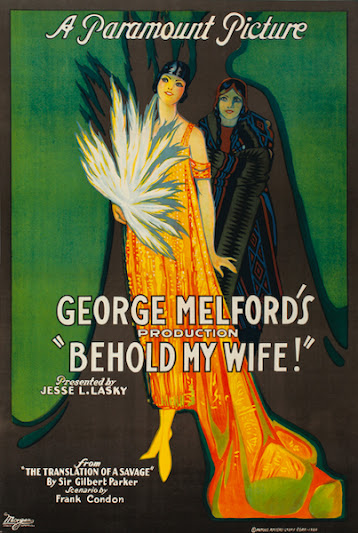Robert Stead
Toronto: Musson, 1920
388 pages
Robert Stead's fourth novel, Dennison Grant follows The Bail Jumper, The Homesteaders, and The Cow Puncher. So, who is Dennison Grant? A cowboy? A cattle rustler? A hired hand? A rodeo clown?
This is not a novel for the impatient. The titular character doesn't appear until the fifty-fifth page. He sticks around for another two before literally riding away. Dennison Grant reappears fifty-four pages later – page 111, for those keeping track – at which point he begins to dominate the narrative.
Grant's first appearance has to do with his work as ranch foreman for a man named Landson. He's been tasked with overseeing the cutting of hay on a vast expanse of what may or may not be Crown land to the east of the Alberta foothills. Y.D., a neighbouring rancher, has had the very same idea, and so there is conflict. From the start, Grant comes off as a polite, level-headed gentleman. Frank Transley, Y.D.'s foreman, comes off nearly as well.Standing in the wings is Zen, Y.D.'s twenty-year-old daughter. She is a minor character at first, but is soon elevated to the main stage through unwanted attention from George Dranzk, one of her father's hired hands.
An impulsive idiot, Dranzk has the idea to set Landson's bails alight so as to win Y.D.'s favour... and with it Zen's hand. The fire spreads quickly, threatening both harvests as both Y.D.'s team and Landson's try to bring it under control.
The novel's most dramatic scene unfolds away from the inferno. Zen rides into the hills so as to warn a local farming family. On her return, she has the misfortune of encountering Dranzk. He tries to force himself upon Zen, and both end up in a river, struggling until the former can struggle no more:
Her hand reached the lash. With a quick motion of the arm, such as is given in throwing a rope, she had looped it once around his neck. Then, pulling the lash violently, she fought herself out of his grip. He clutched at her wildly, but could reach only some stray locks of her brown hair which had broken loose and were floating on the water.
She saw his eyes grow round and big and horrified; saw his mouth open and refuse to close; heard strange little gurgles and chokings. But she did not let go.
"When you insulted me this morning I promised to settle with you; I did not expect to have the chance so soon."His head had gone under water.... Suddenly she realized that he was drowning. She let go of the thong, clutched her horse's tail, and was pulled quickly ashore.
Dennison Grant came west where the work is physical, yet at the core of his being he's a thinking man of "peculiar notions." Grant shares these with Zen as a full moon arcs slowly overhead:
"I have observed," he said, "that poor people worry over what they haven't got, and rich people worry over what they have. It is my disposition not to worry over anything. You said that money is power. That is one of its deceits. It offers a man power, but in reality it makes him its slave. It enchains him for life; I have seen it in too many cases — I am not mistaken. As for opening up a wider life, what wider life could there be than this which I — which you and I — are living."Listening in, it sounds like the worst of first dates with Grant talking only about himself. This is Stead's failing; the author doesn't recognize that his audience knows Zen's backstory while Grant does not. And yet, it somehow works. This reader came away fully convinced that the two were taken with one another.
Zen is no anomaly. The women in Denison Grant are invariably intelligent and independent. Y.D.'s right cheek bears a scar from a branding iron wielded by a young woman in defence of her father. He later married that same young woman, who in turn bore and raised Zen. Another strong woman, a city girl named Phyllis Bruce, is in Grant's future.
"It's [sic] action centres largely in the West, in Calgary and the Foothills" is amusing. No scenes are set in Calgary or any other western city for that matter. In fact, Calgary is not mentioned at all, except as "the principal cow-town of the foothill country."
What is he to do?
I will not spoil things.
Dennison Grant is not for everyone. I recommend it to those interested in post-Great War Canada. This Montrealer, the son of a Calgarian, was fascinated by the preconceptions expressed by Westerners toward Easterners and vice versa. I had no idea they stretched back so far.
Grant expresses his ideas, even though he knows they are not fully formed. He's thinking aloud... after saving Zen, before Y.D., when hiring a lawyer, and during what I'd taken to be a date at a fancy restaurant with Phyllis Bruce. Forget my disappointment, just imagine hers!
It can be tiresome, but no more so than any message novel. Dennison Grant is to Stead what John Galt is to Ayn Rand.
The Russian émigré and Social Security recipient would've hated Dennison Grant, which makes me like it all the more.
Object and Access: A bulky hardcover, typical of its time, I can't for the life of me remember just when or where it was purchased. I have no idea how much I paid, but it could not have been more than two dollars. Evidence suggests that it once belonged to one James Rutherford, whose signature graces the front free paper. Over fifty James Rutherfords are listed in the 1921 census.
At the time of this writing, one copy of the Musson edition (sans jacket) listed for sale at US$17.00. Neither H&S edition is in sight.
Thankfully, it can be read online here at the Internet Archive.























































